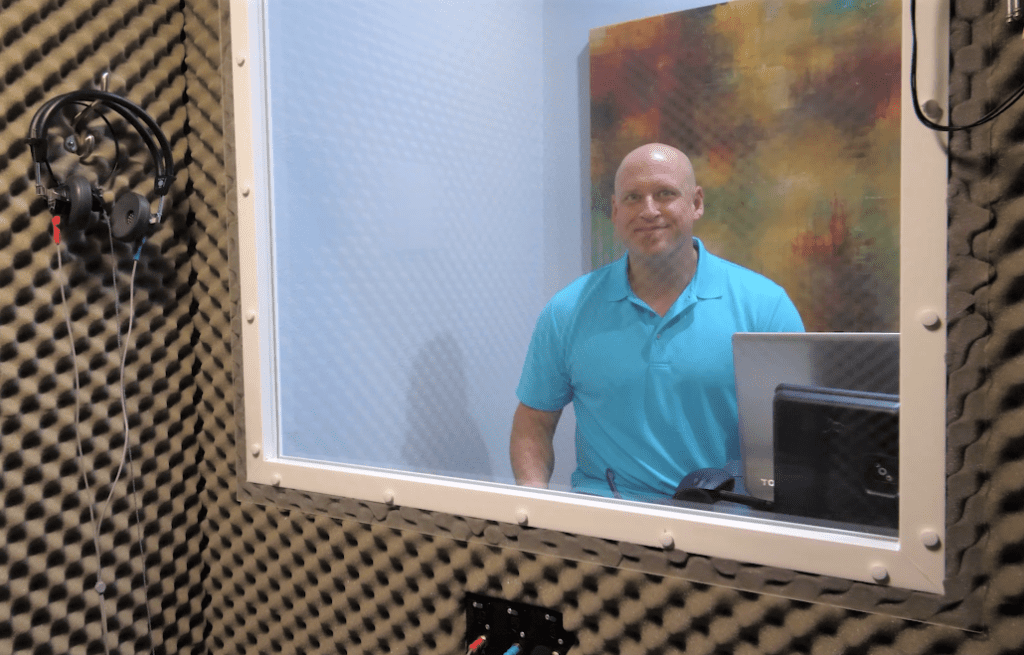
At Micron Audiology Inc., we believe that everyone should have their hearing tested, even if they have normal hearing. Why would you have your hearing tested if you weren’t having trouble hearing? The answer is, if your hearing were to change due to genetics, noise exposure or disease process, it is impossible to determine how much change has taken place without a baseline hearing evaluation to compare. At Micron Audiology Inc., we feel so strongly that everyone should have a baseline audiogram that we provide the service to our patients for free! We also offer a complete battery of diagnostic audiologic evaluations for individuals experiencing symptoms of hearing loss, balance difficulties or ringing in the ears (tinnitus).
The evaluation is done to determine if a hearing loss is present, and if so, to detail the type and severity of the hearing loss. It also may provide insight into the cause of the hearing loss as well as provide guidance in making appropriate treatment recommendations.
What Tests Will Be Done?
The specific tests done during the evaluation will depend on the patient’s age, and what is known already about their hearing status. These tests will determine the degree of hearing loss, the type of hearing loss, and the conditions of the ear canal and middle ear. Our audiologists will also determine if the hearing loss is conductive (middle or outer ear problem), sensorineural (inner ear problem or brain related) or mixed (a combination of conductive and sensorineural).
A diagnostic audiologic evaluation includes video otoscopy, pure-tone testing, bone-conduction testing, and speech testing (including speech in noise testing).
Video Otoscopy
Before we can test your hearing, we need to know that the ear is clear of wax so that we can get an accurate hearing test. The audiologist will use a fiber optic surgical-grade camera to show you the condition of your ear. If wax needs to be removed, we can accomplish this for you before we begin the test or we can refer you to one of our local Ear Nose and Throat specialists to have it removed. You will be able to see the condition of your ear and, if wax is removed, you will be able to watch the entire process. Many of our patients come to Micron Audiology Inc. just to have wax removed periodically. If we see abnormalities in the canal or on the tympanic membrane that look suspicious based on our experience, we would refer you to a local ENT.
Pure-tone Air and Bone Conduction Testing
Pure-tone air conduction testing determines the quietest tones a person can hear at different frequencies, both low and high. Bone conduction testing is similar to pure-tone air conduction testing. A different type of headphone is used during bone conduction testing, and the results help the specialist determine if the hearing loss is originating from the outer/middle ear or from the inner ear (cochlea).
Speech Testing
A speech reception threshold (SRT) test is often used with older children and adults to confirm the results of a pure-tone test. This test determines the softest level of speech a patient can understand using phonetically balanced words like “horseshoe”.
Speech Discrimination Testing in Noise
Speech in noise testing is a valuable tool to evaluate how a hearing impaired person realistically functions in noise. Difficulty hearing in noise is the number one complaint of the hearing impaired population.
Middle Ear Evaluation
The audiologist may also perform tympanometry (test of the middle ear) and reflex testing to determine the health of the ear canal, middle ear and auditory nerves coursing to the auditory cortex.
Audiometry for Children
For children, it is important to have a diagnostic audiologic evaluation whenever a hearing loss is suspected. It is the first step in identifying and treating hearing loss. As with adults, the earlier the detection of loss in children, the better.
Along with the evaluation, you should generally expect to have time to review the results with the audiologist. Our audiologists can interpret the tests, answer your questions, and provide you with information and referrals as needed, as well as begin planning for treatment.
Our audiologists have completed a Master’s degree in hearing science and have a passion for helping you understand the inner workings of the auditory system in a way that makes sense to you. Never hesitate to ask for clarification or further information on anything you do not understand, because we believe that knowledge is only as valuable as it can be understood.
What Can I Expect During a Diagnostic Audiologic Evaluation?
The evaluation will probably last about 30 to 40 minutes. You should also allow time for discussion with the audiologist to review test results and ask questions.
If the determination is made that you need hearing aids, allow for sufficient time to discuss your options.
It is recommended that you bring a family member with you to the evaluation appointment. Hearing loss is something that affects more than just the patient; it affects everyone they care about. It helps to have another supportive person at your appointment to help you understand the information and recommendations.
Before your appointment, a complete medical history will be completed and the audiologist will want to hear about any concerns you have regarding your hearing. Our audiologists will pay special attention to any concerns you have about exposure to noise, tinnitus, or balance problems.
The diagnostic audiologic evaluation is a good chance to establish a relationship with your audiologist. It helps to ask around for recommendations to audiologists in your area and find someone who listens carefully to your concerns. Above all, don’t be afraid to ask questions. You will want to be clear on any information you receive so that you can be an active participant in finding hearing solutions that work best for you and your lifestyle.
